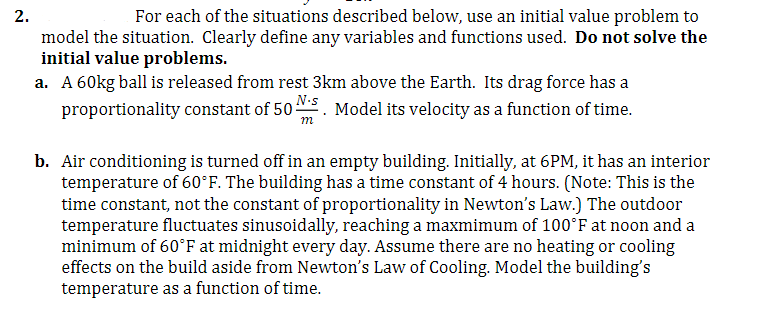For each of the situations described below, use an initial value problem to model the situation. Clearly define any variables and functions used. Do not solve the initial value problems. a. A 60kg ball is released from rest 3km above the Earth. Its drag force has a proportionality constant of 50. Model its velocity as a function of time. b. Air conditioning is turned off in an empty building. Initially, at 6PM, it has an interior temperature of 60°F. The building has a time constant of 4 hours. (Note: This is the time constant, not the constant of proportionality in Newton's Law.) The outdoor temperature fluctuates sinusoidally, reaching a maxmimum of 100°F at noon and a minimum of 60°F at midnight every day. Assume there are no heating or cooling effects on the build aside from Newton's Law of Cooling. Model the building's temperature as a function of time.
For each of the situations described below, use an initial value problem to model the situation. Clearly define any variables and functions used. Do not solve the initial value problems. a. A 60kg ball is released from rest 3km above the Earth. Its drag force has a proportionality constant of 50. Model its velocity as a function of time. b. Air conditioning is turned off in an empty building. Initially, at 6PM, it has an interior temperature of 60°F. The building has a time constant of 4 hours. (Note: This is the time constant, not the constant of proportionality in Newton's Law.) The outdoor temperature fluctuates sinusoidally, reaching a maxmimum of 100°F at noon and a minimum of 60°F at midnight every day. Assume there are no heating or cooling effects on the build aside from Newton's Law of Cooling. Model the building's temperature as a function of time.
Principles of Heat Transfer (Activate Learning with these NEW titles from Engineering!)
8th Edition
ISBN:9781305387102
Author:Kreith, Frank; Manglik, Raj M.
Publisher:Kreith, Frank; Manglik, Raj M.
Chapter5: Analysis Of Convection Heat Transfer
Section: Chapter Questions
Problem 5.18P: The drag on an airplane wing in flight is known to be a function of the density of air (), the...
Related questions
Question

Transcribed Image Text:2.
For each of the situations described below, use an initial value problem to
model the situation. Clearly define any variables and functions used. Do not solve the
initial value problems.
a. A 60kg ball is released from rest 3km above the Earth. Its drag force has a
proportionality constant of 50 . Model its velocity as a function of time.
m
b. Air conditioning is turned off in an empty building. Initially, at 6PM, it has an interior
temperature of 60°F. The building has a time constant of 4 hours. (Note: This is the
time constant, not the constant of proportionality in Newton's Law.) The outdoor
temperature fluctuates sinusoidally, reaching a maxmimum of 100°F at noon and a
minimum of 60°F at midnight every day. Assume there are no heating or cooling
effects on the build aside from Newton's Law of Cooling. Model the building's
temperature as a function of time.
Expert Solution
This question has been solved!
Explore an expertly crafted, step-by-step solution for a thorough understanding of key concepts.
Step by step
Solved in 2 steps

Knowledge Booster
Learn more about
Need a deep-dive on the concept behind this application? Look no further. Learn more about this topic, mechanical-engineering and related others by exploring similar questions and additional content below.Recommended textbooks for you

Principles of Heat Transfer (Activate Learning wi…
Mechanical Engineering
ISBN:
9781305387102
Author:
Kreith, Frank; Manglik, Raj M.
Publisher:
Cengage Learning

Principles of Heat Transfer (Activate Learning wi…
Mechanical Engineering
ISBN:
9781305387102
Author:
Kreith, Frank; Manglik, Raj M.
Publisher:
Cengage Learning